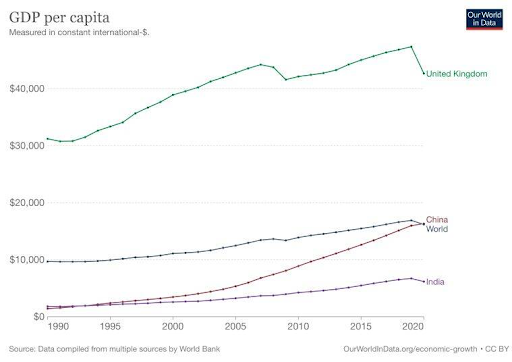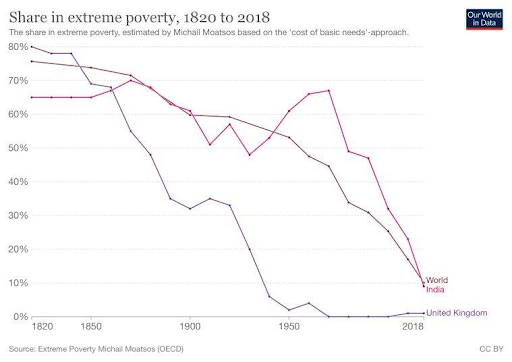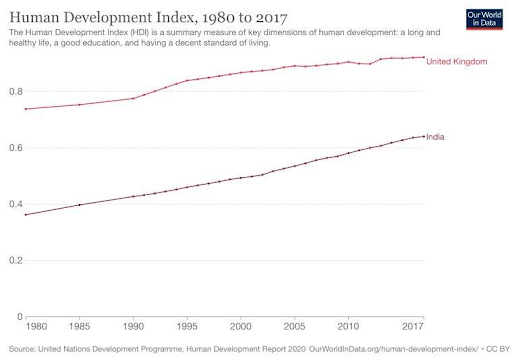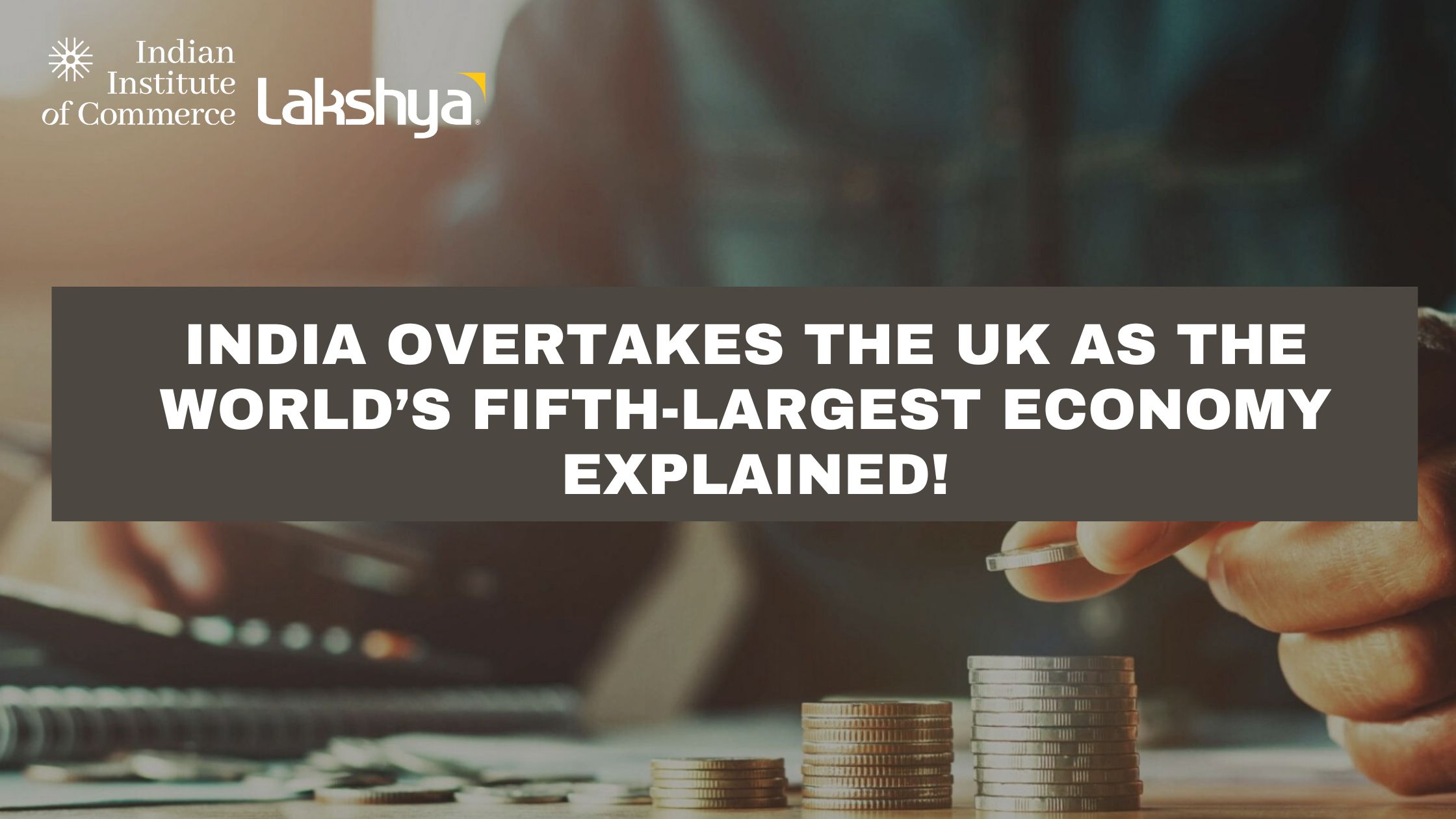India has officially become the world’s 5th largest economy as it overtook the United Kingdom in end-March 2022 as per the calculations by Bloomberg. According to IMF projections, we are now only behind the USA, China, Japan, and Germany.
The Bloomberg report stated ”On an adjusted basis and using the dollar exchange rate on the last day of the relevant quarter, the size of the Indian economy in ‘nominal’ cash terms in the quarter through March was $854.7 billion. On the same basis, the UK was $816 billion,”
The growth of the Indian economy over the years
India was marked as the 9th largest economy in 2010. India briefly did overtake the UK before in the year 2019 to become the 5th largest economy but then shrunk back to position 6 in 2020. It is projected that India will become the world’s 3rd largest economy by 2030. India’s GDP had grown exponentially over the years, and the nominal GDP has been 700% in the last 25 years, And this has enabled us to be on the list of the top economies of the world. As per the IMF’s forecasts, India overtaking the UK in dollar terms on an annual basis in 2022 has put the nation behind the US, China, Japan and Germany.
A decade back while the UK was in the 5th position, India was in position 11. With record beating expansion in the April-June quarter, the Indian economy has now overtaken the U.K., which has slipped to the sixth spot.
How did India become the 5th largest economy in the world?
Let us understand and analyse things a bit better so that we can understand the development with perspective.
Population Size - One of the biggest determining factors for the GDP is population size. As per statistics, India has a population of 1.41 billion whereas the population of the UK is just 68.5 million. This means that India's population is 20 times that of the UK’s.
"Proud moment for India to pip the U.K., our colonial ruler, as the 5th largest economy: India $3.5 trillion vs UK $3.2 trillion. But a reality check of population denominator: India: 1.4 billion vs UK 0.068 billion. Hence, per capita GDP we at $2,500 vs $47,000. We have miles to go... Let's be at it!," Uday Kotak, CEO of Kotak Mahindra Bank, said in a tweet.

India’s population is 20 times that of UK. (Source: Our World in Data)
Per Capita GDP - As we have mentioned earlier there is a huge difference in the population between both nations. The GDP per capita index will give an insight into a more realistic comparison between the income levels as it essentially divides the country’s GDP by the population of the country. But unfortunately, the income of an average Indian is far lower.
"Proud moment for India to pip the U.K., our colonial ruler, as the 5th largest economy: India $3.5 trillion vs UK $3.2 trillion. But a reality check of population denominator: India: 1.4 billion vs UK 0.068 billion. Hence, per capita GDP we at $2,500 vs $47,000. We have miles to go... Let's be at it!," Uday Kotak, CEO of Kotak Mahindra Bank, said in a tweet.

The income of an average Indian is far lower than in the UK. (Source: Our World in Data)
Poverty levels - Whenever the is a low per capita that automatically indicates high levels of poverty. Interestingly at the start of the 19th century, the UK’s levels of extreme poverty were much higher than India’s. But as of today, the positions have been reversed. Even though we have made huge progress in curbing poverty, the numbers are still not in our favour.

India’s and the UK’s share of extreme poverty (Source: Our World in Data)
Human development index - The ultimate goal of attaining a higher GDP is so that there is faster growth in the economy and there are better human development parameters. The Human Development Index is a composite of health, education and standard of living parameters. Even though we are progressively doing much better, it will definitely take us about a decade to get to where the UK was in its 1980s.

India standing on HDI compared with the UK’s. (Source: Our World in Data)
Universal healthcare coverage - Quality of life is a great yardstick to measure how a nation is doing. Most of the young citizens in our nation are also migrating to other nations due to the same reason. The Universal Health Coverage (UHC) Index is gauged from 0 (worst) to 100 (best). This is determined by the average coverage of essential services, which includes services like reproductive, maternal, newborn, child health, infectious diseases, non-communicable diseases and service capacity and access. From the figure below you will be able to note that even though there may be faster economic growth, the government’s policy focus on healthcare schemes since 2005 has made a distinct improvement for India, but there is still a long way to go.
One factor that has definitely helped India is the pent-up demand which is driven by consumption. After almost 2 years of pandemic restrictions, the Indian consumer is eager to step out and spend. The service sector, in particular, has received a drastic boost and will see a steady rise as the festive seasons hit.
An area that is of concern though for our country is our manufacturing sector. The growth in the domain has come down to 4.8% which is a cause for worry. The fact that imports are higher than exports is also a matter of grave concern. Agriculture is also another avenue where a lot of attention is required, uneven monsoon coil weighs upon agriculture growth and rural demand.
The GDP print though is going to be a high favour for RBI as it will allow them to control inflation, which is has been a major issue. Inflation has stayed above the comfort zone of 6% for seven straight months.
How does this impact employment?
Even though our GDP rates have been off the charts beating both China and the USA in terms of growth, we are not able to provide job opportunities for our 1.4 billion population. The unemployment rate in India was about 7% to 8%, which has gone up from 5% 5 years ago. This data is as per the Centre of Monitoring Indian Economy, a private research firm. It can be seen that women and the youth of our nation have been deeply impacted by this. CMIE estimated that unemployment in the 20-24 age group was 43.7% in June. That compares with 18.4% in May for the 16-24 category in China, which is also facing a worsening crisis. The government has announced plans to hire a million people by the end of 2023 to fill vacancies in government departments. Private sector jobs are also mushrooming everywhere such as drivers for Uber Technologies Inc. or delivery workers for Zomato Ltd.
Why are the numbers this bad?
They find that most of the applicants don’t have the skill needed to take up the role. It is now more crucial than ever before to take up a degree or qualification that gives you hands-on skills and makes you job ready that just get you a qualification.
What should be done?
Students should look into vocational courses or look at professionals which are recession proof such as CA, ACCA, MBBS etc which will guarantee that students will get a good job opportunity once they are done with the course.
We will have to wait and see if the job opportunities are growing to grow or not with the growth in the economy.

 ABOUT LAKSHYA
ABOUT LAKSHYA  WHY CHOOSE LAKSHYA
WHY CHOOSE LAKSHYA  MISSION AND VISION
MISSION AND VISION  CHARTERED ACCOUNTANCY (CA)
CHARTERED ACCOUNTANCY (CA)  ACCA
ACCA  CMA-USA
CMA-USA  RESULTS
RESULTS 


